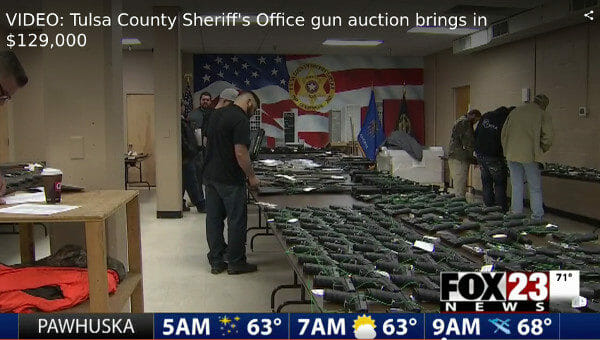
U.S.A. –-(Ammoland.com)- In April, two Oklahoma law enforcement departments auctioned off guns they had accumulated. The guns had not been used in crimes, but were seized for a variety of reasons. They were turned into the police by people who did not want them. They were seized from prohibited possessors. They were forfeited as part of plea deals.
Oklahoma County auctioned off about 500 firearms they had collected. The guns were sold to dealers with federal firearms licenses (FFL).
Tulsa County auctioned off over 700 firearms. They collected $129,000 from the auction. If the price per firearm in Tulsa averaged the same as in Oklahoma County, Oklahoma County would have received about $92,000. It is a nice chunk of change. Costs to run the auctions for a few FFL dealers are minimal. From fox23.com:
The sale brought in over $129,000 to offset the department’s budget.
There is no practical advantage of destroying guns rather than selling them. If a dealer does not buy a gun at the auction, he simply buys one from a manufacturer. When the police sell a gun, the money goes to the department instead of a gun manufacturer. Even broken guns are valuable. Parts outlets will buy broken guns to use for spare parts.
Both Oklahoma County and Tulsa County auctions were conducted by Sheriff departments.
In Oklahoma City and the City of Tulsa, the police departments do not sell the guns they collect. They spend additional money and destroy them.
The number of guns seized in Oklahoma City has been trending up. KGOU says the number seized in 2018 was over 2,000.
The number seized in the City of Tulsa was over 1,500. Both departments go to the extra expense of destroying the firearms rather than selling them to federal dealers. From kgou.org:
Both departments destroy seized guns rather than reuse or sell them at an auction.
“Our goal is not to put guns back out on the street,” Adair said. “Whatever we might get from the sale just isn’t worth it.”
The purpose of destroying guns seems purely ideological. It does not “remove guns from the streets”. Manufacturers are producing millions of guns each year to take up any demand that results from destroyed guns. The guns destroyed would have gone to a dealer, to be sold through exactly the same channels in the same manner as new guns with the same safeguards as new guns.
Using the ratios from the Tulsa County sales, Oklahoma City will be throwing away about $368,000. The City of Tulsa will be throwing away about $276,000 dollars, all to make an obscure ideological point that “guns are bad”.
Part of the difference may be Sheriff’s are directly elected. The head of the police department in Oklahoma City is selected by the City Manager, who is hired by the City Council. It is a political position but twice removed from accountability to the people.
The City of Tulsa Police Chief is appointed by the Mayor of Tulsa. The police department is thus a power center for the Mayor, and the police chief is directly responsible to the Mayor of Tulsa, instead of directly to the electorate, as Sheriffs are.
Historically, urban police departments have access to more tax money and are less concerned with husbanding resources than are rural sheriff departments.
Ideologically, those who want a disarmed population often start their arguments with: “If there weren’t any guns”. They have an emotional attachment to the fantastical notion of a world without guns. This fantasy is fed by sacrificing hundreds of thousands of dollars for their emotional gratification. Mostly, it is someone else’s money.
About Dean Weingarten:
Dean Weingarten has been a peace officer, a military officer, was on the University of Wisconsin Pistol Team for four years, and was first certified to teach firearms safety in 1973. He taught the Arizona concealed carry course for fifteen years until the goal of constitutional carry was attained. He has degrees in meteorology and mining engineering, and recently retired from the Department of Defense after a 30 year career in Army Research, Development, Testing, and Evaluation.
